2010 FORD E150 transmission
[x] Cancel search: transmissionPage 179 of 327
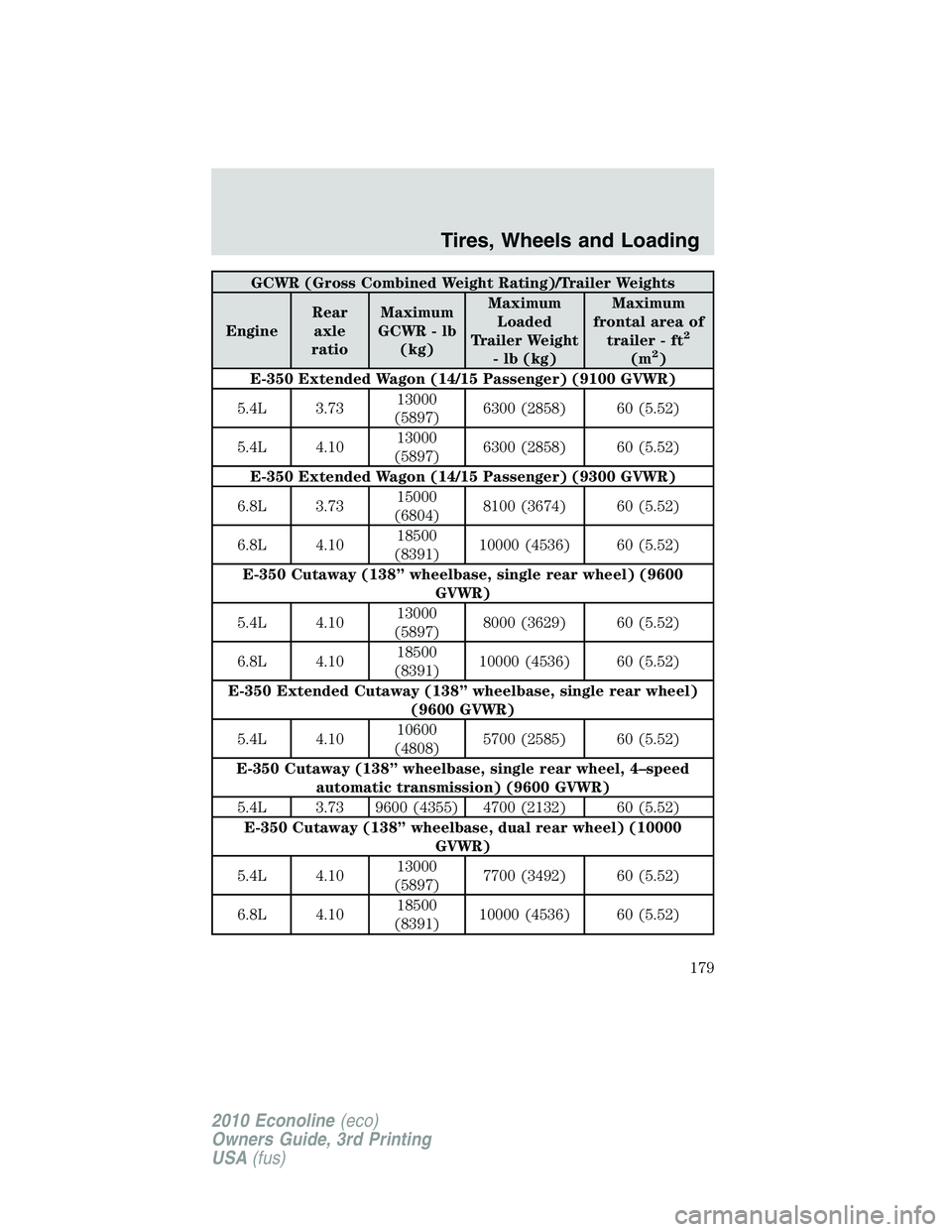
GCWR (Gross Combined Weight Rating)/Trailer Weights
EngineRear
axle
ratioMaximum
GCWR - lb
(kg)Maximum
Loaded
Trailer Weight
- lb (kg)Maximum
frontal area of
trailer - ft
2
(m2)
E-350 Extended Wagon (14/15 Passenger) (9100 GVWR)
5.4L 3.7313000
(5897)6300 (2858) 60 (5.52)
5.4L 4.1013000
(5897)6300 (2858) 60 (5.52)
E-350 Extended Wagon (14/15 Passenger) (9300 GVWR)
6.8L 3.7315000
(6804)8100 (3674) 60 (5.52)
6.8L 4.1018500
(8391)10000 (4536) 60 (5.52)
E-350 Cutaway (138” wheelbase, single rear wheel) (9600
GVWR)
5.4L 4.1013000
(5897)8000 (3629) 60 (5.52)
6.8L 4.1018500
(8391)10000 (4536) 60 (5.52)
E-350 Extended Cutaway (138” wheelbase, single rear wheel)
(9600 GVWR)
5.4L 4.1010600
(4808)5700 (2585) 60 (5.52)
E-350 Cutaway (138” wheelbase, single rear wheel, 4–speed
automatic transmission) (9600 GVWR)
5.4L 3.73 9600 (4355) 4700 (2132) 60 (5.52)
E-350 Cutaway (138” wheelbase, dual rear wheel) (10000
GVWR)
5.4L 4.1013000
(5897)7700 (3492) 60 (5.52)
6.8L 4.1018500
(8391)10000 (4536) 60 (5.52)
Tires, Wheels and Loading
179
2010 Econoline(eco)
Owners Guide, 3rd Printing
USA(fus)
Page 180 of 327
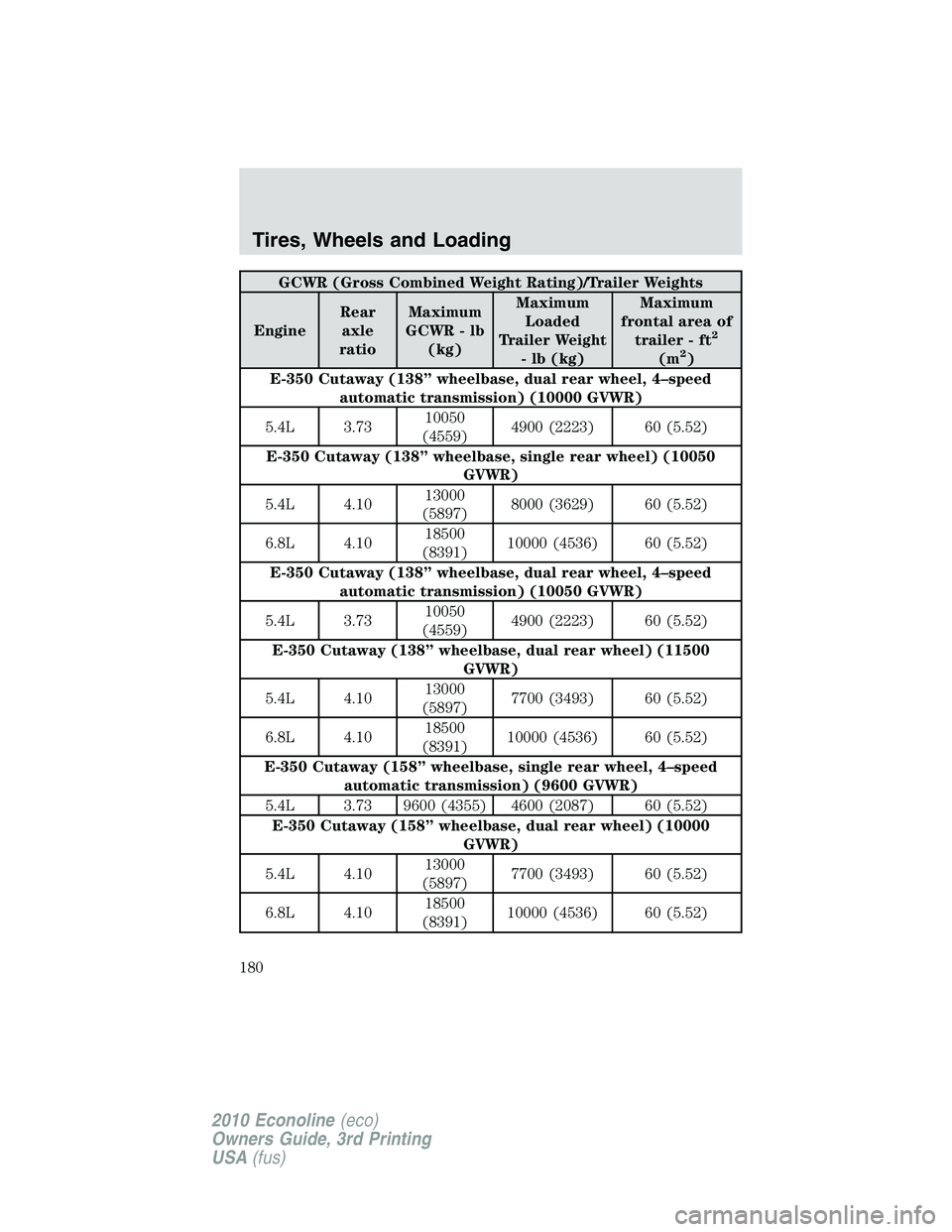
GCWR (Gross Combined Weight Rating)/Trailer Weights
EngineRear
axle
ratioMaximum
GCWR - lb
(kg)Maximum
Loaded
Trailer Weight
- lb (kg)Maximum
frontal area of
trailer - ft
2
(m2)
E-350 Cutaway (138” wheelbase, dual rear wheel, 4–speed
automatic transmission) (10000 GVWR)
5.4L 3.7310050
(4559)4900 (2223) 60 (5.52)
E-350 Cutaway (138” wheelbase, single rear wheel) (10050
GVWR)
5.4L 4.1013000
(5897)8000 (3629) 60 (5.52)
6.8L 4.1018500
(8391)10000 (4536) 60 (5.52)
E-350 Cutaway (138” wheelbase, dual rear wheel, 4–speed
automatic transmission) (10050 GVWR)
5.4L 3.7310050
(4559)4900 (2223) 60 (5.52)
E-350 Cutaway (138” wheelbase, dual rear wheel) (11500
GVWR)
5.4L 4.1013000
(5897)7700 (3493) 60 (5.52)
6.8L 4.1018500
(8391)10000 (4536) 60 (5.52)
E-350 Cutaway (158” wheelbase, single rear wheel, 4–speed
automatic transmission) (9600 GVWR)
5.4L 3.73 9600 (4355) 4600 (2087) 60 (5.52)
E-350 Cutaway (158” wheelbase, dual rear wheel) (10000
GVWR)
5.4L 4.1013000
(5897)7700 (3493) 60 (5.52)
6.8L 4.1018500
(8391)10000 (4536) 60 (5.52)
Tires, Wheels and Loading
180
2010 Econoline(eco)
Owners Guide, 3rd Printing
USA(fus)
Page 181 of 327
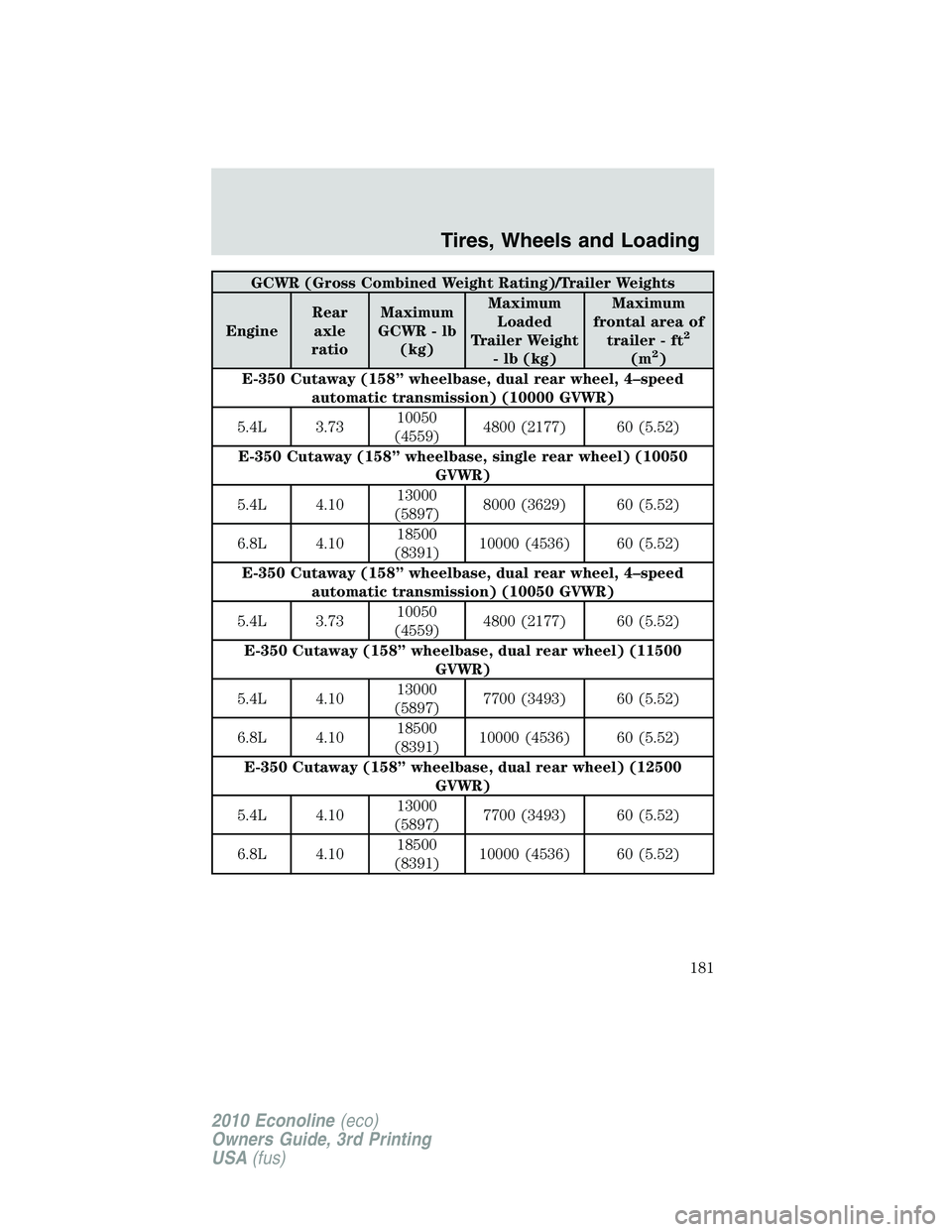
GCWR (Gross Combined Weight Rating)/Trailer Weights
EngineRear
axle
ratioMaximum
GCWR - lb
(kg)Maximum
Loaded
Trailer Weight
- lb (kg)Maximum
frontal area of
trailer - ft
2
(m2)
E-350 Cutaway (158” wheelbase, dual rear wheel, 4–speed
automatic transmission) (10000 GVWR)
5.4L 3.7310050
(4559)4800 (2177) 60 (5.52)
E-350 Cutaway (158” wheelbase, single rear wheel) (10050
GVWR)
5.4L 4.1013000
(5897)8000 (3629) 60 (5.52)
6.8L 4.1018500
(8391)10000 (4536) 60 (5.52)
E-350 Cutaway (158” wheelbase, dual rear wheel, 4–speed
automatic transmission) (10050 GVWR)
5.4L 3.7310050
(4559)4800 (2177) 60 (5.52)
E-350 Cutaway (158” wheelbase, dual rear wheel) (11500
GVWR)
5.4L 4.1013000
(5897)7700 (3493) 60 (5.52)
6.8L 4.1018500
(8391)10000 (4536) 60 (5.52)
E-350 Cutaway (158” wheelbase, dual rear wheel) (12500
GVWR)
5.4L 4.1013000
(5897)7700 (3493) 60 (5.52)
6.8L 4.1018500
(8391)10000 (4536) 60 (5.52)
Tires, Wheels and Loading
181
2010 Econoline(eco)
Owners Guide, 3rd Printing
USA(fus)
Page 182 of 327
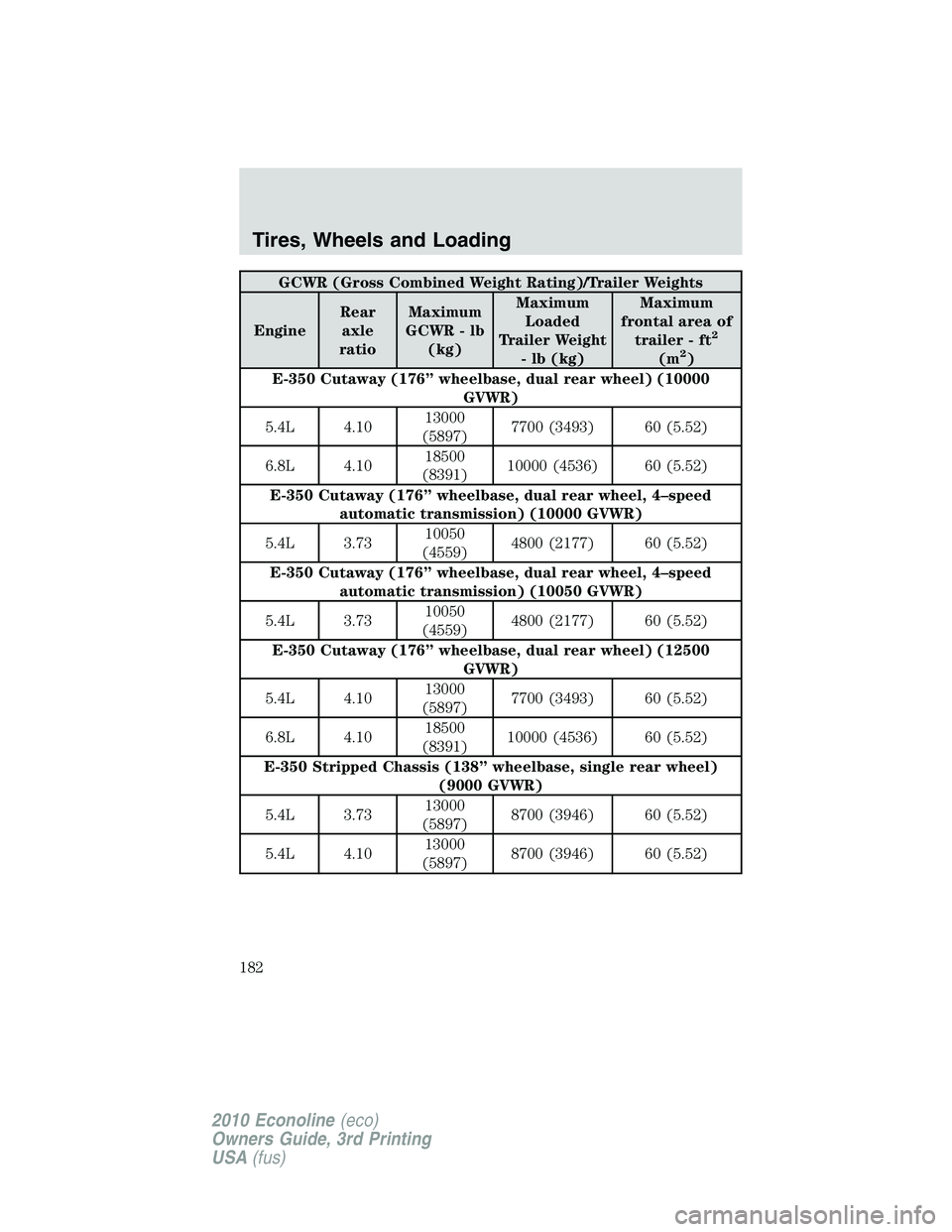
GCWR (Gross Combined Weight Rating)/Trailer Weights
EngineRear
axle
ratioMaximum
GCWR - lb
(kg)Maximum
Loaded
Trailer Weight
- lb (kg)Maximum
frontal area of
trailer - ft
2
(m2)
E-350 Cutaway (176” wheelbase, dual rear wheel) (10000
GVWR)
5.4L 4.1013000
(5897)7700 (3493) 60 (5.52)
6.8L 4.1018500
(8391)10000 (4536) 60 (5.52)
E-350 Cutaway (176” wheelbase, dual rear wheel, 4–speed
automatic transmission) (10000 GVWR)
5.4L 3.7310050
(4559)4800 (2177) 60 (5.52)
E-350 Cutaway (176” wheelbase, dual rear wheel, 4–speed
automatic transmission) (10050 GVWR)
5.4L 3.7310050
(4559)4800 (2177) 60 (5.52)
E-350 Cutaway (176” wheelbase, dual rear wheel) (12500
GVWR)
5.4L 4.1013000
(5897)7700 (3493) 60 (5.52)
6.8L 4.1018500
(8391)10000 (4536) 60 (5.52)
E-350 Stripped Chassis (138” wheelbase, single rear wheel)
(9000 GVWR)
5.4L 3.7313000
(5897)8700 (3946) 60 (5.52)
5.4L 4.1013000
(5897)8700 (3946) 60 (5.52)
Tires, Wheels and Loading
182
2010 Econoline(eco)
Owners Guide, 3rd Printing
USA(fus)
Page 190 of 327
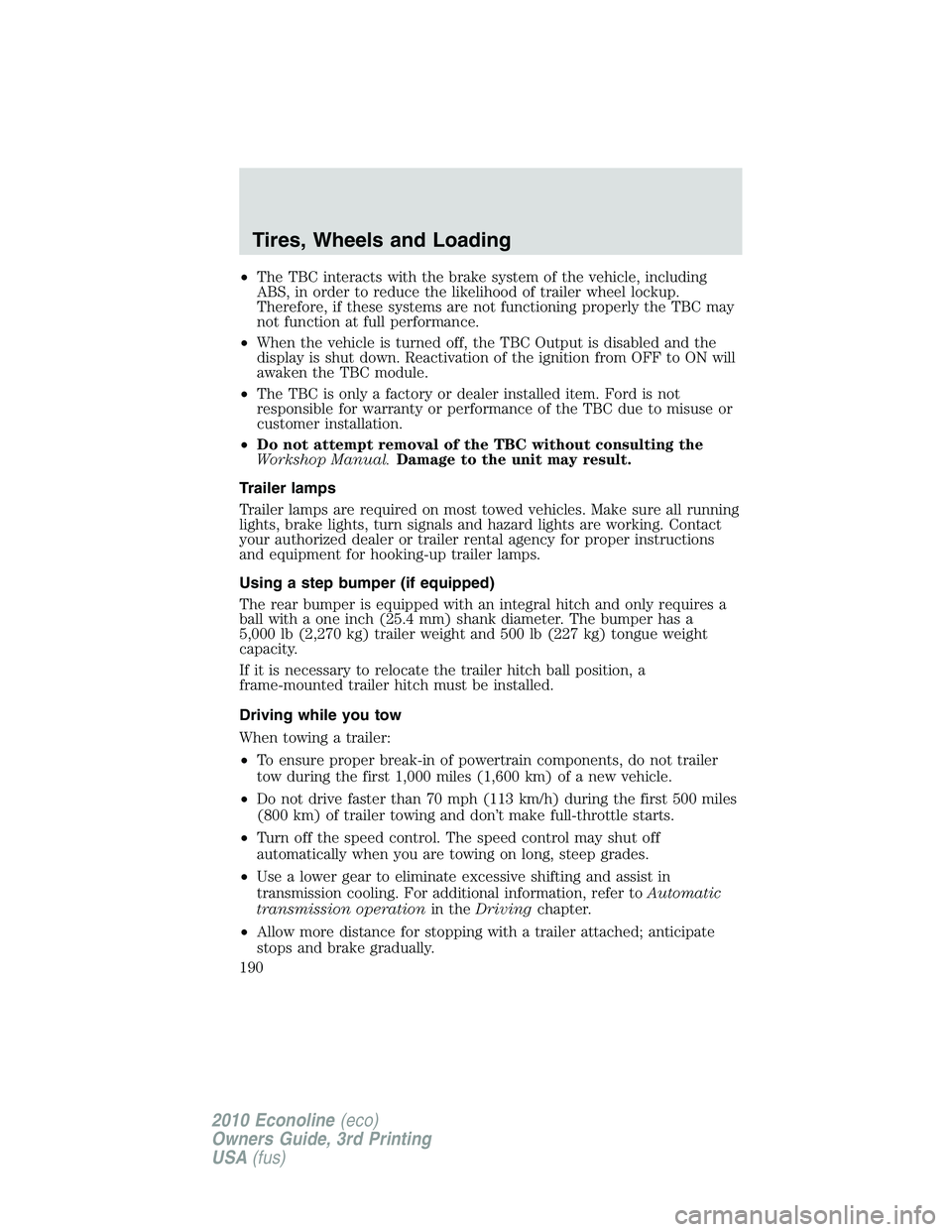
•The TBC interacts with the brake system of the vehicle, including
ABS, in order to reduce the likelihood of trailer wheel lockup.
Therefore, if these systems are not functioning properly the TBC may
not function at full performance.
•When the vehicle is turned off, the TBC Output is disabled and the
display is shut down. Reactivation of the ignition from OFF to ON will
awaken the TBC module.
•The TBC is only a factory or dealer installed item. Ford is not
responsible for warranty or performance of the TBC due to misuse or
customer installation.
•Do not attempt removal of the TBC without consulting the
Workshop Manual.Damage to the unit may result.
Trailer lamps
Trailer lamps are required on most towed vehicles. Make sure all running
lights, brake lights, turn signals and hazard lights are working. Contact
your authorized dealer or trailer rental agency for proper instructions
and equipment for hooking-up trailer lamps.
Using a step bumper (if equipped)
The rear bumper is equipped with an integral hitch and only requires a
ball with a one inch (25.4 mm) shank diameter. The bumper has a
5,000 lb (2,270 kg) trailer weight and 500 lb (227 kg) tongue weight
capacity.
If it is necessary to relocate the trailer hitch ball position, a
frame-mounted trailer hitch must be installed.
Driving while you tow
When towing a trailer:
•To ensure proper break-in of powertrain components, do not trailer
tow during the first 1,000 miles (1,600 km) of a new vehicle.
•Do not drive faster than 70 mph (113 km/h) during the first 500 miles
(800 km) of trailer towing and don’t make full-throttle starts.
•Turn off the speed control. The speed control may shut off
automatically when you are towing on long, steep grades.
•Use a lower gear to eliminate excessive shifting and assist in
transmission cooling. For additional information, refer toAutomatic
transmission operationin theDrivingchapter.
•Allow more distance for stopping with a trailer attached; anticipate
stops and brake gradually.
Tires, Wheels and Loading
190
2010 Econoline(eco)
Owners Guide, 3rd Printing
USA(fus)
Page 191 of 327

When descending long, steep downhill grades, always use a lower gear to
provide engine braking to save wear on brakes. Use D (Overdrive OFF)
on moderately steep hills, 2 (Second) on steep hills, and 1 (First) on
very steep hills.Do not apply your brakes continuously, as they
may overheat and become less effective.
Servicing after towing
If you tow a trailer for long distances, your vehicle will require more
frequent service intervals. Refer to yourscheduled maintenance
informationfor more information.
Trailer towing tips
•The trailer tongue weight should be 10–15% of the loaded trailer
weight.
•Practice turning, stopping and backing-up before starting on a trip to
get the feel of the vehicle-trailer combination. When turning, make
wider turns so the trailer wheels will clear curbs and other obstacles.
•To aid in engine/transmission cooling and A/C efficiency during hot
weather while stopped in traffic, place the gearshift lever in P (Park).
•After you have traveled 50 miles (80 km), thoroughly check your
hitch, electrical connections and trailer wheel lug nuts.
•If you will be towing a trailer frequently in hot weather, hilly
conditions, at GCWR, or any combination of these factors, consider
refilling your rear axle with synthetic gear lube if not already so
equipped. Refer to theMaintenance and Specificationschapter for
the lubricant specification. Remember that regardless of the rear axle
lube used, do not tow a trailer for the first 1,000 miles (1,600 km) of a
new vehicle, and that the first 500 miles (800 km) of towing be done
at no faster than 70 mph (113 km/h) with no full throttle starts.
•Do not tow a trailer for the first 500 miles (800 km) after changing
the rear axle lube.
•Vehicles with trailers should not be parked on a grade. If you must
park on a grade, place wheel chocks under the trailer’s wheels.
Tires, Wheels and Loading
191
2010 Econoline(eco)
Owners Guide, 3rd Printing
USA(fus)
Page 192 of 327
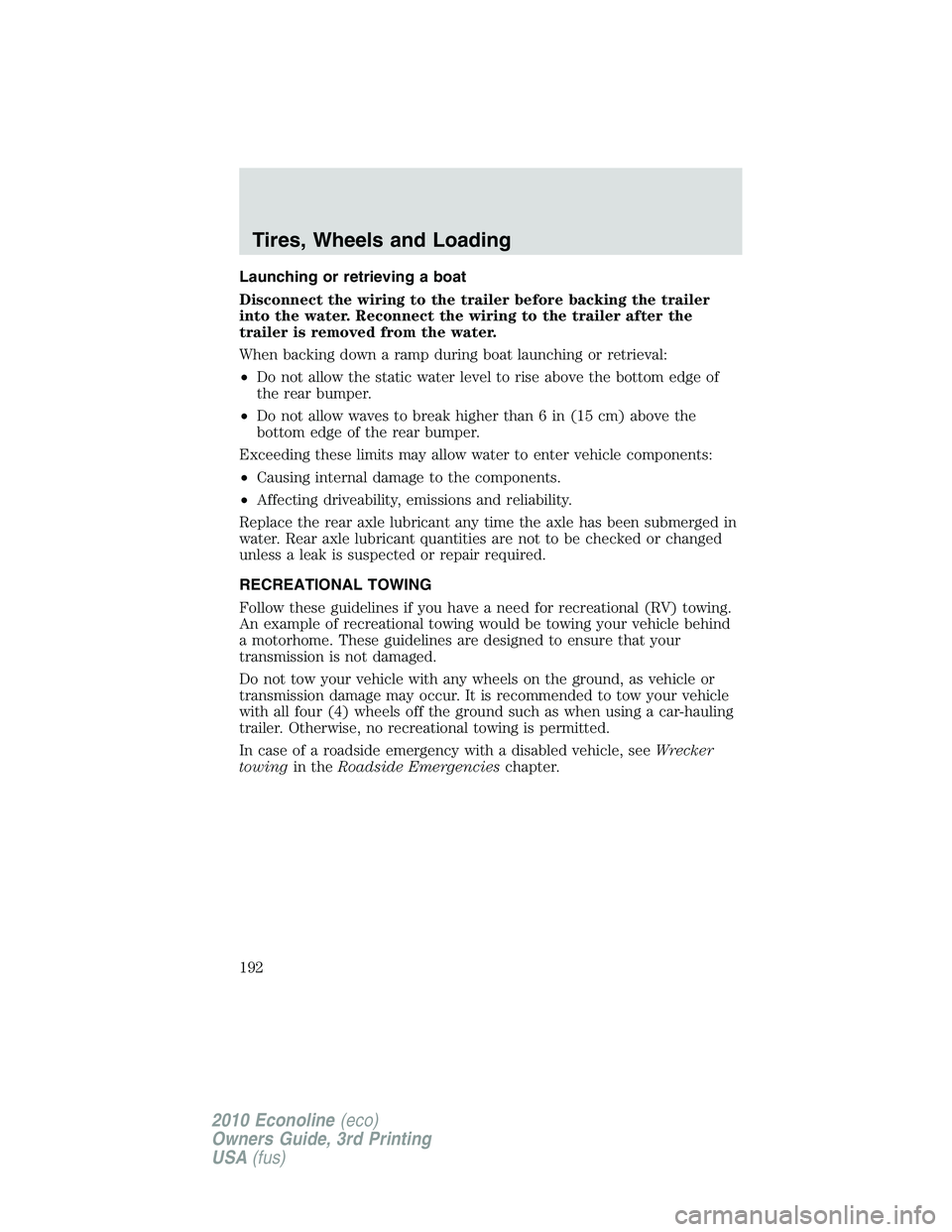
Launching or retrieving a boat
Disconnect the wiring to the trailer before backing the trailer
into the water. Reconnect the wiring to the trailer after the
trailer is removed from the water.
When backing down a ramp during boat launching or retrieval:
•Do not allow the static water level to rise above the bottom edge of
the rear bumper.
•Do not allow waves to break higher than 6 in (15 cm) above the
bottom edge of the rear bumper.
Exceeding these limits may allow water to enter vehicle components:
•Causing internal damage to the components.
•Affecting driveability, emissions and reliability.
Replace the rear axle lubricant any time the axle has been submerged in
water. Rear axle lubricant quantities are not to be checked or changed
unless a leak is suspected or repair required.
RECREATIONAL TOWING
Follow these guidelines if you have a need for recreational (RV) towing.
An example of recreational towing would be towing your vehicle behind
a motorhome. These guidelines are designed to ensure that your
transmission is not damaged.
Do not tow your vehicle with any wheels on the ground, as vehicle or
transmission damage may occur. It is recommended to tow your vehicle
with all four (4) wheels off the ground such as when using a car-hauling
trailer. Otherwise, no recreational towing is permitted.
In case of a roadside emergency with a disabled vehicle, seeWrecker
towingin theRoadside Emergencieschapter.
Tires, Wheels and Loading
192
2010 Econoline(eco)
Owners Guide, 3rd Printing
USA(fus)
Page 193 of 327
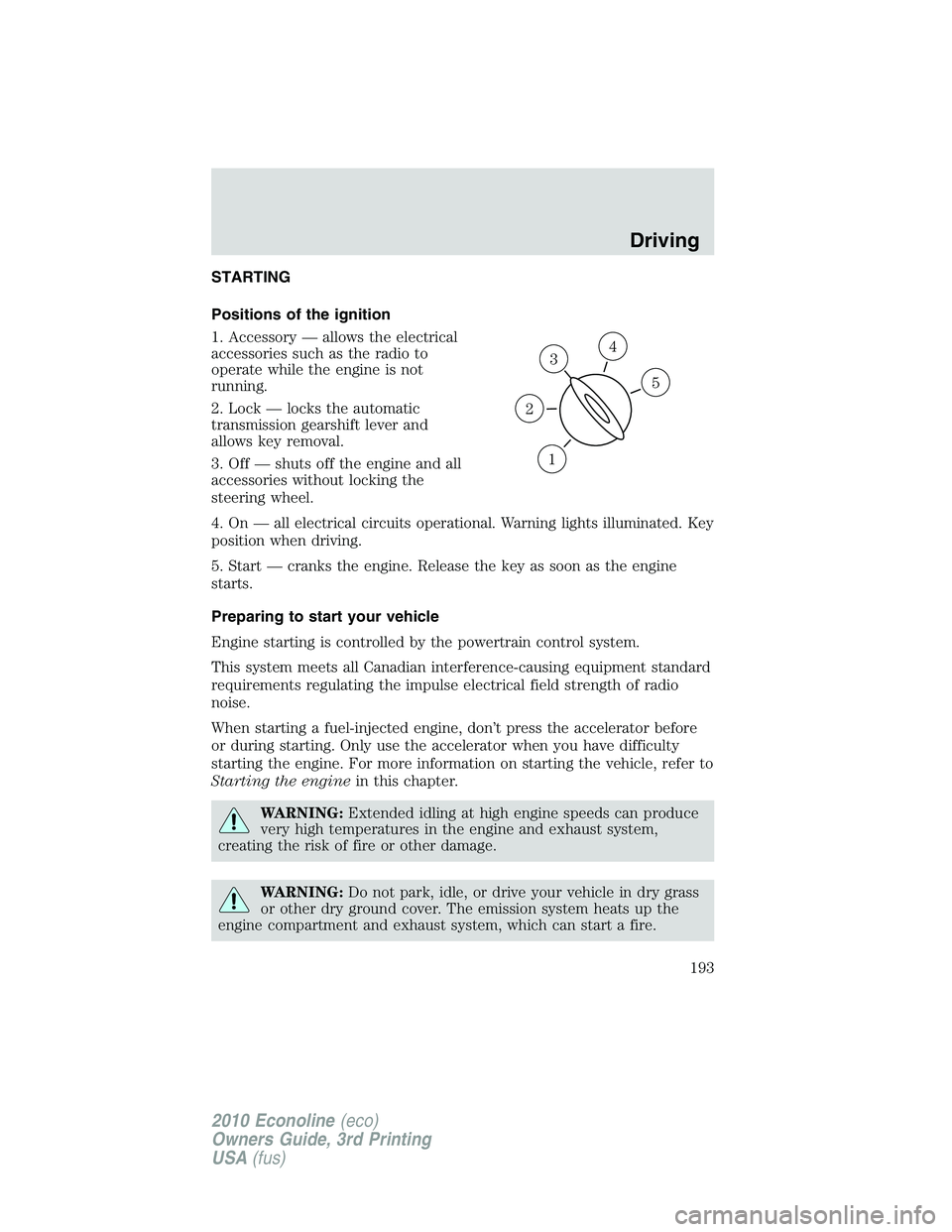
STARTING
Positions of the ignition
1. Accessory — allows the electrical
accessories such as the radio to
operate while the engine is not
running.
2. Lock — locks the automatic
transmission gearshift lever and
allows key removal.
3. Off — shuts off the engine and all
accessories without locking the
steering wheel.
4. On — all electrical circuits operational. Warning lights illuminated. Key
position when driving.
5. Start — cranks the engine. Release the key as soon as the engine
starts.
Preparing to start your vehicle
Engine starting is controlled by the powertrain control system.
This system meets all Canadian interference-causing equipment standard
requirements regulating the impulse electrical field strength of radio
noise.
When starting a fuel-injected engine, don’t press the accelerator before
or during starting. Only use the accelerator when you have difficulty
starting the engine. For more information on starting the vehicle, refer to
Starting the enginein this chapter.
WARNING:Extended idling at high engine speeds can produce
very high temperatures in the engine and exhaust system,
creating the risk of fire or other damage.
WARNING:Do not park, idle, or drive your vehicle in dry grass
or other dry ground cover. The emission system heats up the
engine compartment and exhaust system, which can start a fire.
3
1
2
5
4
Driving
193
2010 Econoline(eco)
Owners Guide, 3rd Printing
USA(fus)